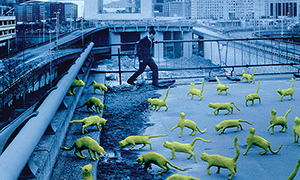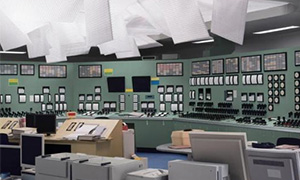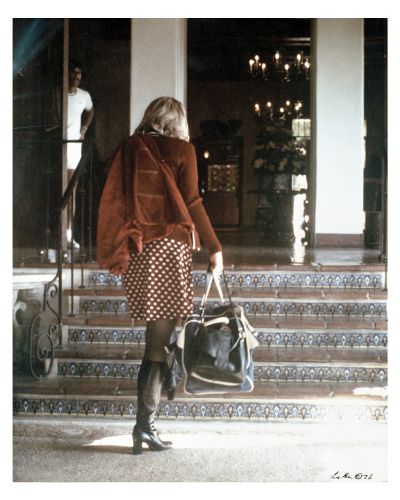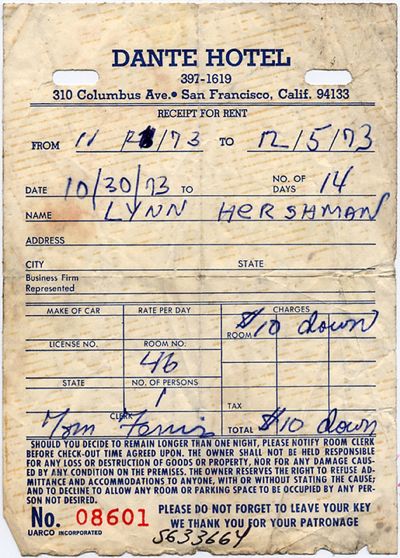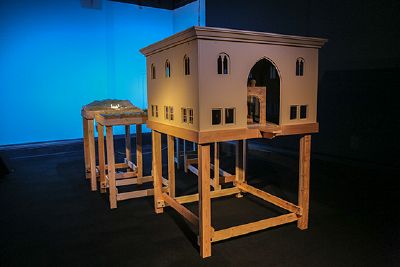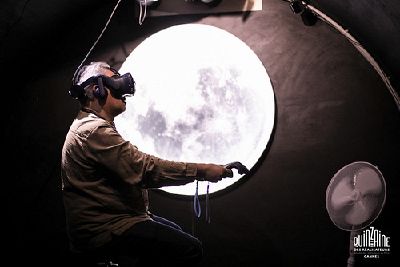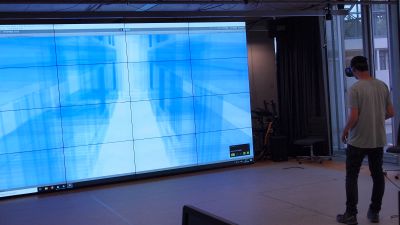No edit summary |
mNo edit summary |
||
| Line 57: | Line 57: | ||
“[...] in a plane[...] You settle into your seat, look out the window. You can also get up and move up and down the aisle. Soon the plane takes off and you notice some shafts of light appearing in the ceiling and floor. Then the plane begins to fall apart. Your worst nightmare. [...] You begin to reach out with your suddenly visible virtual hands to touch and hold the debris and objects that float past. You touch a lily and it shatters into pieces that become the words of a story or song.” (Quinzaine des Réalisateurs, 2019) | “[...] in a plane[...] You settle into your seat, look out the window. You can also get up and move up and down the aisle. Soon the plane takes off and you notice some shafts of light appearing in the ceiling and floor. Then the plane begins to fall apart. Your worst nightmare. [...] You begin to reach out with your suddenly visible virtual hands to touch and hold the debris and objects that float past. You touch a lily and it shatters into pieces that become the words of a story or song.” (Quinzaine des Réalisateurs, 2019) | ||
== Formality and Structure == | == Formality and Structure == | ||
| Line 102: | Line 106: | ||
“Do we stand on a stable floor?” By posing this question, Dear My Tilted Floor gives people a thread of clues about awareness of their own understanding of the vulnerability of our body in these atmospheric environments. Within the methodology of forensic aesthetics, the collection of voice, thought, traces of places, gesture, and intention demonstrates these series of entangled movements with theatricality, narrative, and dramatization (Weizman). Through this experimental journey, the thing that I hope to convey is the danger of standstill, reinforced by a superficial instruction system which is believed to be concrete, yet could be truly meaningless and can even take our soul from our body. And our beloved, after they go back to nature, or no longer physically exist next to us, remain only as a memory of the shared happiness and nostalgia of our past present and future. That is, the thought and memory of our beautiful absence of beings endures now and also in the future. How light and at the same time how heavy is the weight of our beings. | “Do we stand on a stable floor?” By posing this question, Dear My Tilted Floor gives people a thread of clues about awareness of their own understanding of the vulnerability of our body in these atmospheric environments. Within the methodology of forensic aesthetics, the collection of voice, thought, traces of places, gesture, and intention demonstrates these series of entangled movements with theatricality, narrative, and dramatization (Weizman). Through this experimental journey, the thing that I hope to convey is the danger of standstill, reinforced by a superficial instruction system which is believed to be concrete, yet could be truly meaningless and can even take our soul from our body. And our beloved, after they go back to nature, or no longer physically exist next to us, remain only as a memory of the shared happiness and nostalgia of our past present and future. That is, the thought and memory of our beautiful absence of beings endures now and also in the future. How light and at the same time how heavy is the weight of our beings. | ||
Latest revision as of 20:42, 30 September 2019
- Week 3. Conceptual Development 1- Diagram
- Week 7. Study - Placeless Place
- Week 9. Artists References 90' and contemporary VR
- Week 9. Concept Sketches
VR Experiment: Dear My Tilted Floor (tentative title)
[1]
https://www.youtube.com/watch?v=TKeeA2Ul53U
Virtuality and Immersion
For a long time, the concept of virtuality has been spreading throughout our everyday life as a form of narratives. Storytelling in all its forms immerses the audience in a facsimile of the outside world as a means of interpreting and understanding our culture. Examples of tools that have been utilized for such virtuality include: (1) black ink - paper, (2) camera - actor - stage set, (3) the public - web platforms, etc. Children's books have often been written in order to convey the dangers of the outside world. The Library of Babel, made up of hexagonal galleries reflecting the infinite periodicity of the universe, has been constructed over and over again in our heads by the language of Borges. Every single day, local cinema, TV channels, Netflix and Amazon deliver countless stories which lure the audience in front of high definition LED screens. Through social networks and streaming services, the border between producer and consumer has been blurred, as people can now easily broadcast their own or virtual character's life.
Figure 1
Figure 2
Nowadays in the art world, the terms virtual or virtuality have been used for a thematic approach and/or accepted as an innovative extension of gear and its aesthetic journey through computer-generated simulation used for artwork. With the introduction of two artists, Sandy Skoglund [Figure 1] and Thomas Demand [Figure 2], in Themes of Contemporary Art, McDaniel and Robertson show the thematic approach, in the case of using virtuality in ‘Constructed Tableau’. According to them, constructed space is an alter-space, which is separated from reality but has its own identity. Mimesis of the place creates its own atmosphere, which cannot be realized by representation and symbolization of the real place. Besides, they affirm that the peculiarity arises from the recognition of conception of the production of imitative representation, which is not a reality.
Figure 3
Figure 4
Figure 5
Another thematic usage of virtuality related to subjectivity and realization of alter-ego can be seen in the case of the artistic experiments of the American artist, Lynn Hershman. As an additional and virtual identity of herself, Hershman created “Roberta Breitmore” [Figure 3] who has been officially and legally alive in the actual world through self-transformation (make-up) and physical evidence of being (her own flat, drivers license, credit card, bank account, receipt of the reservation of a hotel room [Figure 4] and letter from a psychiatrist). Through the presence of Breitmore over a six year period, Hershman demonstrated that her subjectivity is divided by two different beings which cannot parallel exist in the same place, and differentiated the meaning of environments of her own- , and alter-ego. Another artist group, Janet Cardiff and George Miller, has produced binaural sounds with their three dimensional representation, Conversation with Antonello [Figure 5], commissioned by the National Gallery. By contemplating and recreating a physical model of St. Jerome in His Study (1475), the artists try to grasp the debris and pieces of reality of the Renaissance by following the eyes of the painter, Antonello da Messina. In this study and throughout the reconstruction process, the hollow of virtuality arises as a component of the thematic approach, and it grows into a window which allows the soundscape in the possibilities of reality.
Figure 6
Lastly, unlike the previous two cases, Laurie Anderson & Hsin-Chien Huang show their fantastic virtuality through the lens of virtual reality (VR), which extends the visualized illusion. From the cutting-edge tools and process of this work, we can definitely feel that the deepest layers have been derived from the medium and the artist’s thematic path behind the virtual scenes. The depth of the art is produced by the innovation and connotation of gear, which lets people not only be inside of omni-present, illusional space, but also be placed in parallel installations of the physical euclidean space and placeless place of VR. Likewise, the juxtaposed reality and virtuality in this art installation changes, so to say, how people bodily experience and perceive the place. At one of their three works at the Cannes Film Festival 2019, ALOFT, the low, generous and warm voice of Anderson leads the audience into the immersion of a two-layered bodily experience:
“[...] in a plane[...] You settle into your seat, look out the window. You can also get up and move up and down the aisle. Soon the plane takes off and you notice some shafts of light appearing in the ceiling and floor. Then the plane begins to fall apart. Your worst nightmare. [...] You begin to reach out with your suddenly visible virtual hands to touch and hold the debris and objects that float past. You touch a lily and it shatters into pieces that become the words of a story or song.” (Quinzaine des Réalisateurs, 2019)
Formality and Structure
From the influence and coherent contextual connections with these previous relevant artworks, my work Dear My Tilted Floor (tentative title) has been created. Dear My Tilted Floor is about movement and vibration of the lithosphere of our earth; but it is not a physical earthquake, rather a psychological tremor. This tremor is realized on the earth-floor in reality and VR with the formative gaps between different dimensional structures composed of three different levels. These three levels consist of the place where an audience stands, a form of a sculpture, and a series of virtual illusions in VR. The very first place in reality and VR is shown as the world based on spatial bias and our conventional phenomenological perception. The second structure, which is presented as a form of sculpture, is depicted as part of the expanded world from human knowledge, in a differently scaled site-specific place. It could be seen as a manifestation of mimesis of the structure in virtual reality, and as an imitative world of VR in reality, which is based on the invention of innovative medium for cinematic computer graphic imagery. Lastly, the abstracted theatricality and the perceptual projection of the artist in the world of VR, which is generated by logic, numeric, sign and science, is materialized by connotation of theme. The structure of these abstracted places in VR and its imitative representation, sculpture, resembles the rotation of the earth, and has a character of floating around in another immaterial dimension as one of the overlapped spaces, so called, Heterotopia. As Günzel explains in his book, Raumtheorie, there is a collective experience between the placeless place, Utopia, and the localized Utopia, Heterotopia. That is, there are sources of humanistic empathy and collective understanding between the multiple dimensional viewport and collapsing/overlapping of physical borders. This theory is applied to the construction of the structure experiment; accordingly, the psychological tremor of present, where I am, penetrates to the governance of public space in 2014, and reaches to the individual level over the last 70 years. This whole delivers the narrative on what should have been done, the absence of the beloved and the exposure of the virtuality of this medium coming back to the very first place at the end. Therefore, the three media (reality, computer-generated simulation [VR], imitative representation of the structure of VR in reality as a form of sculpture), at the end, forms the shape of the ouroboros, a snake which swallows its own tail.
Three Stages of VR Places
Figure 7
Like the number of media used for the structure between reality and virtual reality, the stages of VR space are divided into three levels: Weltraum, Governance and Individuality, and these stages each express themselves through the process of ontological resemblance to these three images: tilted floor, ship and home. Unlike the partial collision or overlapping of the three media (reality, VR and sculpture) these three stages flow as temporal environments embracing the audience, and passing over time, the story of each stage switches to the next one, as if the Act 2 of the show comes after Act 1. As if winter appears after spring, summer and autumn.
When a spectator enters the very first place of VR, an abstracted representation of the real space, a female voice suddenly recites a part of a poem about love and absence. The representation of the place is not exactly the same but has the same scale of the place and is given precisely the same localization of body of both real and virtual spaces in the euclidean coordinate system. During the recitation, the spectator focuses on the meaning of the poem and at the same time roams around the abstracted representation of the place, the ocular sensation and tactile perception slowly collide with each other by the tilting of the virtually, electronically generated floor and stationary aspect of floor in the real place, which are sharing the sense of gravity. The subject of the remaining audio-visual sensation, then, is soaked into the transitional space and the next public place, which contains the collective trauma of the Korean people in 2014.
The second scene starts off with the metaphoric images of ship and water. This scene illustrates what should have been done whenever the control and communication system in a social organism is broken. During the Sewol Ferry tragedy which took more than 300 lives, only the very few people who trusted their natural instinct had a chance to survive the disaster. Yet, those who followed the instruction of the irresponsible crew, sadly, could not survive from this cold ironic frame. Inside the bedroom of the ship, the only trace of the existential human beings are some voices. The user’s point of view is embedded into an object on a small cupboard next to the window [Figure 7]. Sound of passengers fill the place, yet, soon, the announcement of the captain echoes again and again. “According to the instruction of our crew, please, all passengers come up to the deck. This is an emergency situation.” Voice of angry high school boy against the unbelievable situation and urgent footsteps of other people fill the whole space, then the floor begins to tilt. The horizon of the sea rises and reaches the top of the window. Slowly, the whole soundscape decreases and the place is soaked in the white space, which means nothing but whole.
The white space transitions our body to the third scene, a dreamy place compounded from memories of somebody’s home between 1995 and 2010. Similarly, like Pallasmaa explained, “perception, memory and imagination are in constant interaction; the domain of presence fuses into images of memory and fantasy” (Pallasmaa, 2012). The traveling viewpoint of our spectator becomes a girl in the place. Her grandmother, who does not live with her parents anymore, is sitting in the living room, and there is a dog next to her, which became a part of our stardust in this March in Busan. She and her grandmother are, soon, having a conversation about her photographs and childhood in Nagasaki, Japan in the 1930's.
After this whole journey, the user comes back to the very first place, where reflects the real place, and receives instruction for the alienation effect, which indicates it is not a real world and instructs how to get out of this world of VR.
Matter of Virtual Reality and Our Body
“Matter doesn’t evolve in time. Matter does time. Matter materializes and enfolds different temporalities.” Dr. Karen Barad describes this character of matter in How Matter Matters. What then, in this decisive notion of her writing, does this term matter exactly mean? As stated in the Oxford dictionary, matter originated from the Latin materia, ‘timber, substance’, also ‘subject of discourse’, from mater ‘mother’. This root developed nowadays not really differentiated path: ‘Physical substance in general, as distinct from mind and spirit; (in physics) that which occupies space and possesses rest mass, especially as distinct from energy’ (Oxford Dictionary). The term is also defined as a subject or situation under consideration, reasons of any problem or contents of a text.
Considering these slightly different but similar meanings, the substantiality of the VR medium naturally overlaps with Barad’s further descriptions by recognizing “an agentive role in its ongoing materialization”, which means the active performativity becoming a bodily form. And this role includes these aspects of matter to which Barad referred: “Physical matters, matters of fact, matters of concern, matters of care, matters of justice.” The hollow of the current place where the user stands, the interior of the sunken Sewol Ferry, and a 90’s era flat in South Korea are generated with digitized polygons, based on electricity produced by biochemical energy sources, and textures and materials from aesthetic abstraction of remaining evidence and memory. The place is a “placeless place” but contains a visual narrative and acoustic soundscape around the user’s body. And then, whole scenes lay down on the structural platform of the manifold’s smooth topology.
Among these circumstantial situations, until now, our human body remains as a subject or a metamorphosing object. After the user connects the VR gear with their sensory organs, the phenomenologically perceivable environment compounds with the hollow which is either absent, or present, either dead or alive. Then the experience flows as if mirroring the resemblance of the movement of the structure in VR. Even though we have a nostalgic feeling about our past and future, it cannot be rewound or skipped to a certain point in our life. This condition of our body is, indeed, applied on the being in the VR as well. Our body in this VR project, therefore, should follow the time sequence until the beginning of the scene becomes the end and the VR glasses are taken off.
Conclusion
“Do we stand on a stable floor?” By posing this question, Dear My Tilted Floor gives people a thread of clues about awareness of their own understanding of the vulnerability of our body in these atmospheric environments. Within the methodology of forensic aesthetics, the collection of voice, thought, traces of places, gesture, and intention demonstrates these series of entangled movements with theatricality, narrative, and dramatization (Weizman). Through this experimental journey, the thing that I hope to convey is the danger of standstill, reinforced by a superficial instruction system which is believed to be concrete, yet could be truly meaningless and can even take our soul from our body. And our beloved, after they go back to nature, or no longer physically exist next to us, remain only as a memory of the shared happiness and nostalgia of our past present and future. That is, the thought and memory of our beautiful absence of beings endures now and also in the future. How light and at the same time how heavy is the weight of our beings.
REFERENCES
Barad, K. (2013). 2. “Ma(r)king Time: Material Entanglement and Re-membering: Cutting Together-Apart” - How Matter Matters. Oxford University Press 2013, pp. 16 - 19
Dünne, J. at el (2006). Raumtheorie: Grundlagentexte aus Philosophie und Kulturwissenschaften. Suhrkamp Verlag, pp. 321
Lachmann, R., Rieger, S. (2003). Kittler, F., “Der Mensch, ein betrunkener Dorfmusikant” - Text und Wissen: Technologische und anthropologische Aspekte. Gunter Narr Verlag Tübingen, pp. 29
McDaniel, C., and Robertson, J (2005). Themes of Contemporary Art: Visual Art After 1980. Oxford University Press, pp. 248 - 250
Pallasmaa, J. (2012). “Spaces of Memory and Imagination”, The Eyes of the Skin. Wiley; 3 edition (May 14, 2012), pp. 73-74
Quinzaine des Réalisateurs. (2019). THREE VIRTUAL REALITY INSTALLATIONS BY LAURIE ANDERSON & HSIN-CHIEN HUANG [Press kit], online. Available at <https://www.quinzaine-realisateurs.com/app/uploads/2019/05/Laurie-Anderson-press-kit-en-def3.pdf>, accessed 01 July, 2019
Vernadsky, V. (1938). “The Transition From the Biosphere To the Noösphere” Scientific Thought as a Planetary Phenomenon. trans. Jones, W. Spring-Summer 2012, 21st CENTURY
Weizman, E. (2012). “Forensische Architektur. Notizen von Feldern und Foren”, dOCUMENTA (13): 100 Notes - 100 Thoughts, 100 Notizen - 100 Gedanken No. 062. Hatje Cantz Verlag, pp.10
PICTURE CREDITS
Figure 1. Sandy Skoglund, Cats in Paris, 1993 AP 13/15 unframed / Telluride Gallery of Fine Art
Figure 2. Thomas Demand, Control Room, 2011 / VG Bild-Kunst, courtesy Sprüth Magers
Figure 3. Lynn Hershman Leeson, Roberta Climbs Steps of Del Coronado Hotel to Meet a Date, 1975 / Waldburger Wouter, Brussels
Figure 4. Lynn Hershman Leeson, Hotel bill from The Dante Hotel, November 30, 1973 - August 31, 1974 / KW Institute for Contemporary Art
Figure 5. Cardiff & Miller, Conversation with Antonello, 2015 / <https://www.cardiffmiller.com/artworks/inst/conversation_antonello.html#>
Figure 6. Laurie Anderson & Hsin-Chien Huang, Installation Photos of GO WHERE YOU LOOK!, 15 - 25 May 2019
Figure 7. Photo: Daniel Kempton
